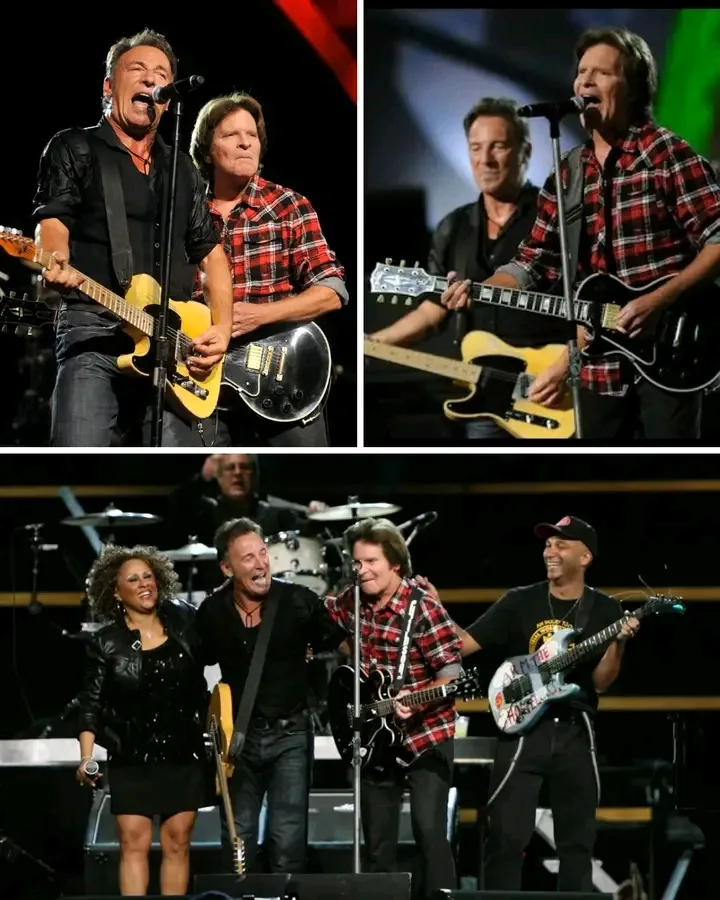In the hushed anticipation of that night, the crowd sensed that something extraordinary was about to unfold. Over 12,000 fans, packed into the grand arena, had gathered not merely to see a performance but to witness a rare convergence of legends—a moment where history and music intertwined in a tapestry of raw emotion and shared memory. As the lights dimmed and the spotlight focused, the air thickened with anticipation. Then, with a gentle yet commanding presence, Bruce Springsteen stepped onto the stage, his iconic guitar slung over his shoulder, eyes gleaming with a mixture of reverence and excitement.
But Springsteen was not alone. At his side stood John Fogerty, the legendary frontman of Creedence Clearwater Revival, a figure whose voice had shaped the soundtrack of a generation and whose influence still resonated decades later. Their presence was a testament to the enduring power of music to bridge eras, to connect souls across the decades. This was no ordinary concert; it was a reunion of spirits, a celebration of the roots that grounded rock ’n’ roll.
As the opening notes of the song rippled through the arena, a hush fell over the crowd. The first riff of “Proud Mary” erupted with a fiery energy that seemed to lift the very roof. But this was no typical cover rendition. It was a resurrection—a rebirth of a song that had once defined a cultural revolution. Springsteen and Fogerty didn’t just perform it; they relived it. Their voices intertwined, echoing the spirit of the original but infused with the wisdom and emotion of their years on the road.
The crowd responded instinctively, rising to their feet in perfect unison, as if compelled by an invisible force. The collective energy surged through the arena, transforming the space into a living organism pulsating with shared history and hope. Eyes welled up with tears—not just from the beauty of the music but from what it represented: a time capsule transporting everyone back to an era when dreams were loud and the world still felt young.
In that moment, the song transcended its status as a mere cover. It became a monument—a carved-in-stone memory of a time when music was rebellion and liberation, when every note was a battle cry. Springsteen and Fogerty, seasoned veterans of the stage, embodied that spirit, channeling the raw power and unfiltered emotion that made the song an anthem. Their voices, weathered yet resilient, carried the weight of history, reminding everyone present of the enduring magic of rock ’n’ roll.
The performance was a seamless blend of reverence and innovation. Fogerty’s gritty, unmistakable voice complemented Springsteen’s soulful delivery, creating a harmony that seemed to echo through the ages. The guitar solos soared with an electrifying intensity, making the audience feel as if they were part of a shared experience—an emotional journey that defied time and space. Every chord struck, every lyric sung, was a testament to the enduring legacy of the artists and the song’s timeless message of resilience and freedom.
Throughout the performance, a palpable sense of unity filled the arena. Fans who had come from all corners of the world found themselves united in a collective reverence. The moment was a living, breathing tribute—not just to the artists on stage but to the generations of musicians and fans who had kept the spirit of rock alive through decades of change. It was a reminder that, in the face of shifting trends and fleeting fame, the true power of music lies in its ability to evoke memories, inspire hope, and foster connection.
As the final notes resonated and the song drew to a close, the crowd erupted into thunderous applause, applause that carried a deeper meaning—one of gratitude, nostalgia, and shared celebration. Springsteen and Fogerty exchanged a knowing glance, their smiles reflecting the profound impact of what had just transpired. It wasn’t just a performance; it was a moment etched into the annals of rock history—a testament to the enduring, unbreakable bond between artists and their audience.
That night, “Proud Mary” was more than a song. It was a time machine, a rallying cry, a shared memory that reminded everyone present of the boundless power of music to transport, heal, and unite. And in that fleeting, electrifying instant, over 12,000 fans and two legendary musicians had together relived a piece of history—an indelible chapter in the ongoing story of rock ’n’ roll.
